INTRACOM TELECOM SOLUTIONS SN6250F12HW16 Point-to-Point Gigabit Radio 60 GHz User Manual StreetNode 6250 PTP with Embedded Node Manager
INTRACOM S.A. TELECOM SOLUTIONS Point-to-Point Gigabit Radio 60 GHz StreetNode 6250 PTP with Embedded Node Manager
Contents
- 1. Installation manual
- 2. Commissioning Manual
Commissioning Manual

StreetNode 6250 PTP with Embedded Node Manager
WebGUI Commissioning Manual - Ed1.1
-I-
Document Revision History
Revisions • Previous Edition: 1.0
• Current Edition: 1.1
•
Reasons of
change The table below shows the reasons of the document change:
Change
A ( added)
M ( modified)
R
(removed)
Radiation Safety & FCC Statements
A

StreetNode 6250 PTP with Embedded Node Manager
WebGUI Commissioning Manual - Ed1.1
-II-
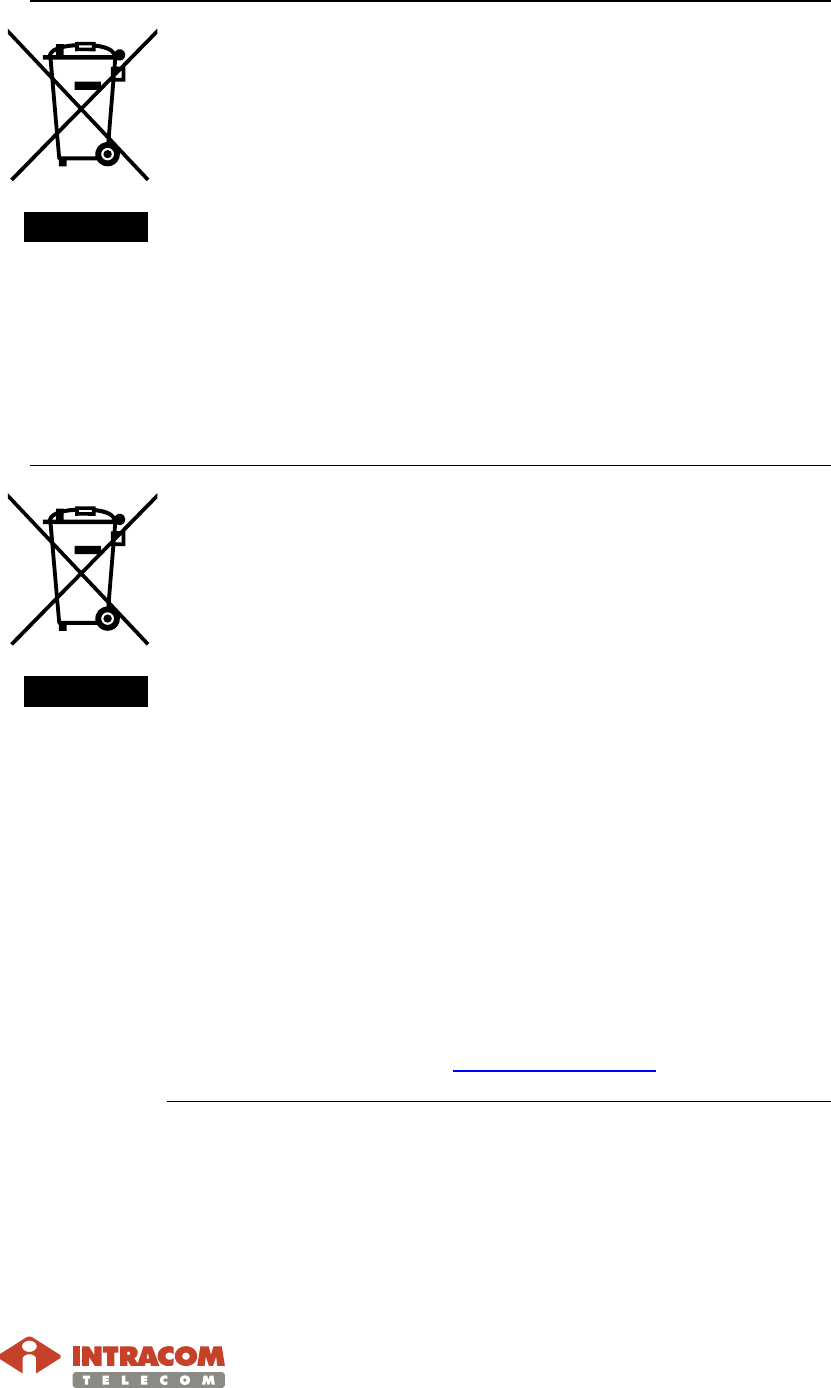
StreetNode 6250 PTP with Embedded Node Manager
WebGUI Commissioning Manual - Ed1.1
-III-
Equipment Disposal
•
Disposal of old electrical and electronic equipment (applicable through the
European Union and other European countries with separate waste collection
systems).
This symbol, found on this product and any of its parts or on its operating instructions
or on its packaging, indicates that electrical and electronic equipment may not be
disposed of as unsorted municipal waste. Instead, this product should be handed over
to applicable collection points for the recycling of electrical and electronic equipment.
By ensuring the correct disposal of this product, you will help prevent potential
negative consequences to the environment and human health, which could otherwise
be caused by inappropriate disposal of this product.
By recycling, reusing and other forms of recovery of old electrical and electronic
equipment you are making an important contribution to the conservation of natural
resources and to the protection of the environment.
For more information about the recycling of this product, please contact your local
municipal authorities, municipal waste disposal service or the store where you
purchased this product.
•
Απόρριψη παλαιών ηλεκτρικών και ηλεκτρονικών συσκευών (ισχύει στην
Ευρωπαϊκή Ένωση και άλλες Ευρωπαϊκές χώρες με συστήματα χωριστής
συλλογής απορριμμάτων).
Το σύμβολο αυτό, που απεικονίζεται πάνω στο προϊόν και σε τυχόν εξαρτήματα του
ή στο εγχειρίδιο οδηγιών του ή στη συσκευασία του, δείχνει ότι οι ηλεκτρικές και
ηλεκτρονικές συσκευές, μετά το πέρας της λειτουργίας τους, δεν θα πρέπει να
απορρίπτονται μαζί με τα αστικά απόβλητα. Αντίθετα θα πρέπει να παραδίδονται σε
κατάλληλα σημεία συλλογής για την ανακύκλωση των ηλεκτρικών και ηλεκτρονικών
συσκευών.
Διασφαλίζοντας τη σωστή απόρριψη αυτού του προϊόντος, συνεισφέρετε στην
πρόληψη πιθανών αρνητικών συνεπειών στο περιβάλλον και την ανθρώπινη υγεία,
οι οποίες θα μπορούσαν να προκληθούν από την μη ενδεδειγμένη απόρριψη του
προϊόντος.
Η ανακύκλωση, επαναχρησιμοποίηση και άλλες μορφές αξιοποίησης των παλαιών
ηλεκτρικών και ηλεκτρονικών συσκευών βοηθούν στη διαφύλαξη των φυσικών πόρων
και στην προστασία του περιβάλλοντος.
Για περισσότερες πληροφορίες σχετικά την ανακύκλωση αυτού του προϊόντος,
παρακαλούμε επικοινωνήστε με τις τοπικές δημοτικές αρχές, την υπηρεσία
αποκομιδής αστικών αποβλήτων ή το κατάστημα από το οποίο αγοράσατε το
συγκεκριμένο προϊόν.
Για περισσότερες πληροφορίες, μπορείτε να επικοινωνείτε με το Συλλογικό Σύστημα
Εναλλακτικής Διαχείρισης Αποβλήτων Ηλεκτρικού και Ηλεκτρονικού Εξοπλισμού
“Ανακύκλωση Συσκευών Α.Ε.”
(www.electrocycle.gr
).

StreetNode 6250 PTP with Embedded Node Manager
WebGUI Commissioning Manual - Ed1.1
-IV-
Declaration of Conformity
•
Hereby, Intracom S.A. Telecom Solutions declares that the product
StreetNode
6250 PTP is CE marked, complying with the requirements of
the R&TTE Directive 1999/5/EC , EMC Directive 2004/108/ΕC, LVD
Directive 2006/95/ΕC, ΕCO Design Directive 2009/125/EU & with the
requirements of the RoHS Directive 2011/65/ΕU.
The product complies to all relevant FCC regulations.
For further information, please refer to Appendix A: Standards of Compliance
on page 12.
Δήλωση Συμμόρφωσης
•
Με την παρούσα, η Intracom Α.Ε. Τηλεπικοινωνιακών Λύσεων δηλώνει ότι
το προϊόν StreetNode
6250 PTP φέρει την σήμανση CE συμμορφούμενο
προς τις απαιτήσεις και τις λοιπές διατάξεις των οδηγιών R&TTE 1999/5/EC,
EMC 2004/108/ΕC, LVD 2006/95/ΕC, ΕCO Design 2009/125/EU καθώς και
με τις απαιτήσεις της οδηγίας RoHS 2011/65/EU.
Το προϊόν συμμορφώνεται σε όλους τους σχετικούς κανονισμούς της
Ομοσπονδιακής Επιτροπής Τηλεπικοινωνίων της Ηνωμένων Πολιτειών
Αμερικής (FCC).
Για περισσότερες πληροφορίες παρακαλώ δείτε το παράρτημα Appendix A:
Standards of Compliance στην σελιδα 12.
•

StreetNode 6250 PTP with Embedded Node Manager
WebGUI Commissioning Manual - Ed1.1
-V-
Radiation Safety
Introduction Any radio equipment is emitting Radio Frequency (RF) radiation through its
antenna.
In the StreetNodeTM 6250 PTP radio, the antenna is integrated and located
inside the unit’s enclosure.
It is important to follow any local, national or international regulation during
installation and operation of the radio equipment to minimize radiation
hazards.
Regulations Many countries have issued and follow their own RF safety regulations,
while many others have adopted international regulations, standards or
guidelines.
In Europe, some countries follow the recommendations included in the
1999/519/EC directive, which is based on the guidelines document published
by the International Commission on Non-Ionizing Radiation Protection
(ICNIRP).
The above mentioned European directive provides the reference levels
(limits) for assessment of the human exposure to electromagnetic fields
based on health effects. Other regulators may define different reference
levels.
The European Union and U.S. regulator (FCC) Reference Levels for the
microwave frequencies are given below:
Regulation Frequency,
GHz Electric
Field
Strength
Power Flux
density
Notes
1999/519/EC 2.0 – 300 61 V/m 10 W/m2 General Public
FCC OET 65 1.5 – 100 - 1 mW/cm2
(10 W/m2)
General Public
FCC OET 65 1.5 – 100 - 5 mW/cm2
(50 W/m2)
Occu-pational
Continued on next page

StreetNode 6250 PTP with Embedded Node Manager
WebGUI Commissioning Manual - Ed1.1
-VI-
Radiation Safety, Continued
General
installation
guidelines
(RF exposure)
As a general rule, it is expected that the highest level of emission would be
at the antenna emission lobe maximum, in direct line-of-sight condition and
in the close vicinity of the antenna.
Additional requirements for the installation of the StreetNodeTM 6250 PTP
radio shall be as follows:
• The radio should be located in such a way to prevent the public from
accessing the area where the RF radiation exceeds the regulation limits.
For this, a compliance boundary is determined, based on its radio
characteristics. Outside this area, the RF radiation levels are below the
reference levels (limits).
• Operation and maintenance personnel, which have to work within the RF
radiation compliance boundary area, should be informed about the source
of radiation and should have the capability to power off the radio
equipment before entering the compliance boundary area.
• The compliance boundary area should be defined by a relevant warning
sign or physical barrier.
Continued on next page

StreetNode 6250 PTP with Embedded Node Manager
WebGUI Commissioning Manual - Ed1.1
-VII-
Radiation Safety, Continued
Compliance
boundary
definition
The Compliance Boundary Definition for StreetNodeΤΜ 6250 PTP is shown to
the following table below:
Parameter
Value
Max EIRP 40,0 dBm 10,0 W
Max EIRP (worst case conditions) ~47,0 dBm ~50,00 W
Power Flux Density Limit (General Public) 10,0 W/m2
Compliance Boundary (General Public)
0,64
m
Power Flux Density Limit (Occupational) 50,0 W/m2
Compliance Boundary (Occupational) 0,29 m
The above calculations are based on information available at the
time of issue of the current document.
RF exposure compliance boundary studies / reports are available
upon request.
References
-
1999/519/EC, COUNCIL RECOMMENDATION of 12 July 1999
on the limitation of exposure of the general public to
electromagnetic fields (0 Hz to 300 GHz).
- OET Bulletin 65, Evaluating Compliance with FCC Guidelines for
Human Exposure to Radiofrequency Electromagnetic Fields,
Edition 97-01, August 1997.
- GUIDELINES FOR LIMITING EXPOSURE TO TIME-VARYING
ELECTRIC, MAGNETIC, AND ELECTROMAGNETIC FIELDS
(UP TO 300 GHz), International Commission on Non-Ionizing
Radiation Protection (ICNIRP), 1998

StreetNode 6250 PTP with Embedded Node Manager
WebGUI Commissioning Manual - Ed1.1
-VIII-
FCC Part 15.19 Statement: Information to the User
This device complies with Part 15 of the FCC Rules. Operation is subject to
the following two conditions:
(1) this device may not cause harmful interference, and
(2) this device must accept any interference received, including interference
that may cause undesired operation.
FCC Part 15.21 Statement: Information to the User
Changes or modifications made to this equipment, not expressly approved
by the party responsible for compliance, could void the user's authority to
operate the equipment.
FCC Part 15.105 Statement: Information to the User
This equipment has been tested and found to comply with the limits for a
Class A digital device, pursuant to part 15 of the FCC rules.
These limits are designed to provide reasonable protection against harmful
interference when the equipment is operated in a commercial environment.
This equipment generates, uses, and can radiate radio frequency energy
and, if not installed and used in accordance with the instruction manual, may
cause harmful interference to radio communications.
Operation of this equipment in a residential area is likely to cause harmful
interference in which case the user will be required to correct the
interference at his own.
Integrated Bluetooth Module FCC ID
The unit contains a certified Bluetooth Module.
The end user has no access to this module.
The FCC ID of the internal Bluetooth module can be found after the phrase
“Contains FCC ID” on the label displaying the FCC IDs related to the unit.
This label is visible on the side of the unit.

StreetNode 6250 PTP with Embedded Node Manager
WebUI Commissioning Manual – Edition 1.1
1
Table of Contents
1. Introduction ................................................................................................ 2
2. Startup & Commissioning ......................................................................... 3
Safety Precautions ....................................................................................... 4
Hardware & Software Requirements ............................................................ 5
Connecting the Laptop ................................................................................. 6
Assumptions ................................................................................................. 7
Startup & Commissioning Procedure ........................................................... 8
System LED Indications ............................................................................. 11
Appendix A: Standards of Compliance .................................................................. 12
Glossary .................................................................................................................... 13

StreetNode 6250 PTP with Embedded Node Manager
WebUI Commissioning Manual – Edition 1.1
2
1. Introduction
Scope This document provides detailed startup, commissioning and
operation instructions for the following equipment:
• StreetNode 6250 PTP with embedded Node
Manager (NM) software.
Target
audience The procedures described in this manual can be carried out by
any technician with basic skills in computer-aided commissioning
of outdoor electrical equipment.
Reference
manuals
Other necessary information about product features and set-up can
be found in the related product documents :
Ite
m Product Documents Description
1
StreetNodeTM 6250 PTP System Description.
2 StreetNodeTM 6250 PTP Installation & Cabling
Manual.
3
StreetNodeTM 6250 PTP Node Manager -
Reference Manual.
4
StreetNodeTM 6250 Release Notes.

StreetNode 6250 PTP with Embedded Node Manager
WebUI Commissioning Manual – Edition 1.1
3
2. Startup & Commissioning
Topics • Safety Precautions
•
• Before starting any commissioning works please refer to
Reference manuals item 2 on page 2.
• Hardware & Software Requirements
• Connecting the Laptop
• Assumptions
• Startup & Commissioning Procedure
•
System LED Indications

StreetNode 6250 PTP with Embedded Node Manager
WebUI Commissioning Manual – Edition 1.1
5
Hardware & Software Requirements
Hardware / Software
Description
Laptop with the following
minimum requirements:
• CPU x86, 9th generation
(Intel Core 2 or AMD
ATHLON II Neo).
• 250 MB HDD.
• 512 MB RAM.
• Network interface card.
• Windows XP or later
version.
Ethernet cable
(CAT5e, straight-through).
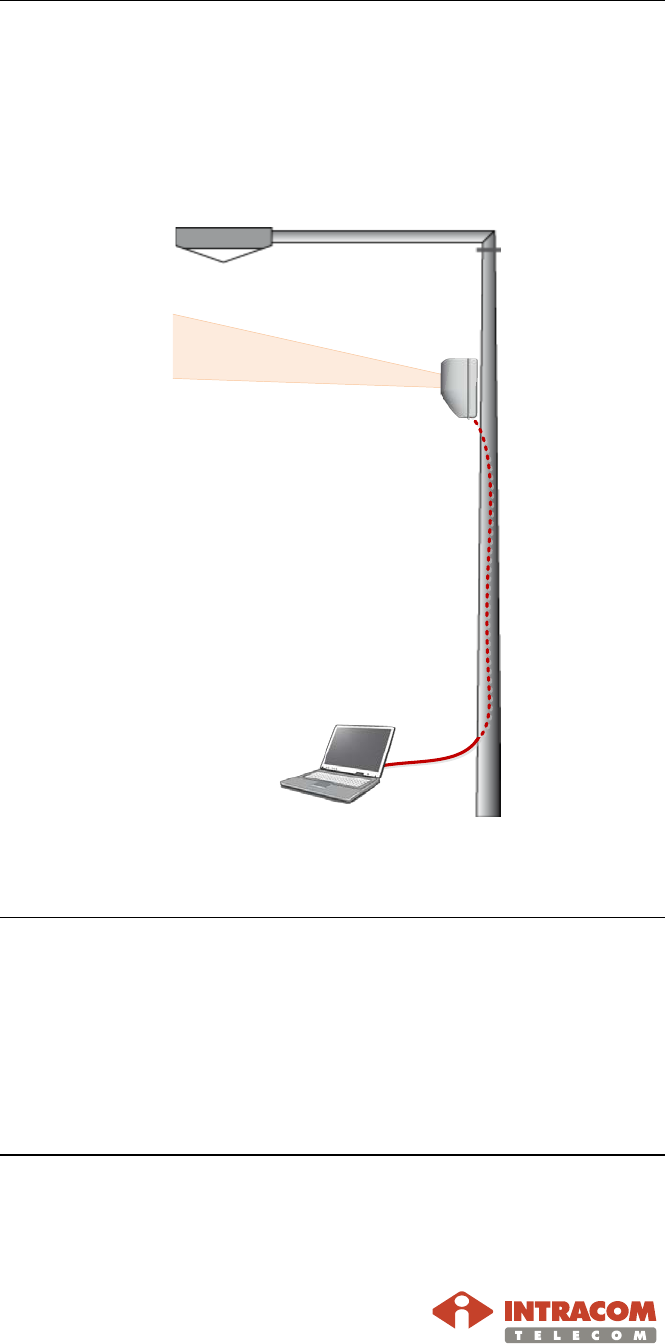
StreetNode 6250 PTP with Embedded Node Manager
WebUI Commissioning Manual – Edition 1.1
6
Connecting the Laptop
Where to
connect The laptop can be connected directly to the StreetNodeTM 6250
PTP node, in any of its available traffic interfaces located
underside:
• Gigabit Ethernet 1 (electrical, RJ-45).
• Gigabit Ethernet 2 (electrical, RJ-45).
• Gigabit Ethernet 3 (SFP).
Laptop
StreetNode
GbE
Ethernet
cable
(Power supply cabling is not shown for simplicity).
Procedure By using an appropriate equipment lifter vehicle (for elevating to
the installation position) and an Ethernet cable, connect the laptop
to one of the Ethernet / SFP ports at the bottom of the
StreetNodeTM 6250 PTP box.
If an Ethernet cable is already pre-installed, unplug it and connect
the laptop with another Ethernet cable. Restore everything as
found after finishing with the startup and commissioning.

StreetNode 6250 PTP with Embedded Node Manager
WebUI Commissioning Manual – Edition 1.1
7
Assumptions
For reader’s convenience, we make the following assumptions
regarding the startup and commissioning procedure:
• Site A – the location of the StreetNodeTM 6250 PTP node
that is closest to customer’s PoP (Point of Presence) and
is the node that will be installed first.
• Site B – the location of the StreetNodeTM 6250 PTP node
that is farther away from customer’s PoP (with respect to
Site A) and is the node that will be installed second.
• “Local” is meant the StreetNodeTM 6250 PTP unit that the
commissioner is directly connected to (using a laptop).
• “Remote” is meant the StreetNodeTM 6250 unit that the
commissioner is connected to remotely and by using a
laptop connected to “local” unit.
The StreetNodeTM 6250 PTP “Local” node, located closest to
network synchronization source, will retrieve synchronization
from its Gigabit Ethernet ports and will transport it to the next
terminating StreetNodeTM 6250 PTP node over the air
medium.
The StreetNodeTM 6250 PTP “Remote” node will retrieve
network synchronization from its modem port and will
transport it (to the next terminating StreetNodeTM 6250 PTP
node) through its Gigabit Ethernet ports.

StreetNode 6250 PTP with Embedded Node Manager
WebUI Commissioning Manual – Edition 1.1
8
Startup & Commissioning Procedure
Introduction On the following pages, an overview of the startup and
commissioning procedure is provided.
For detailed instructions on the included steps, the reader is
prompted to the respective section of the Reference Manual of the
Node Manager for StreetNode
TM
6250 PTP.
Precautions
You must configure the modem operation of all
StreetNodeTM 6250 PTP nodes (participating in the
link) so that:
• Both nodes are configured to have the same
channel bandwidth / size and adaptive mode.
• If MAC header suppression is enabled for
one node, the same must be done for the
other node(s) of the link.
Continued on next page
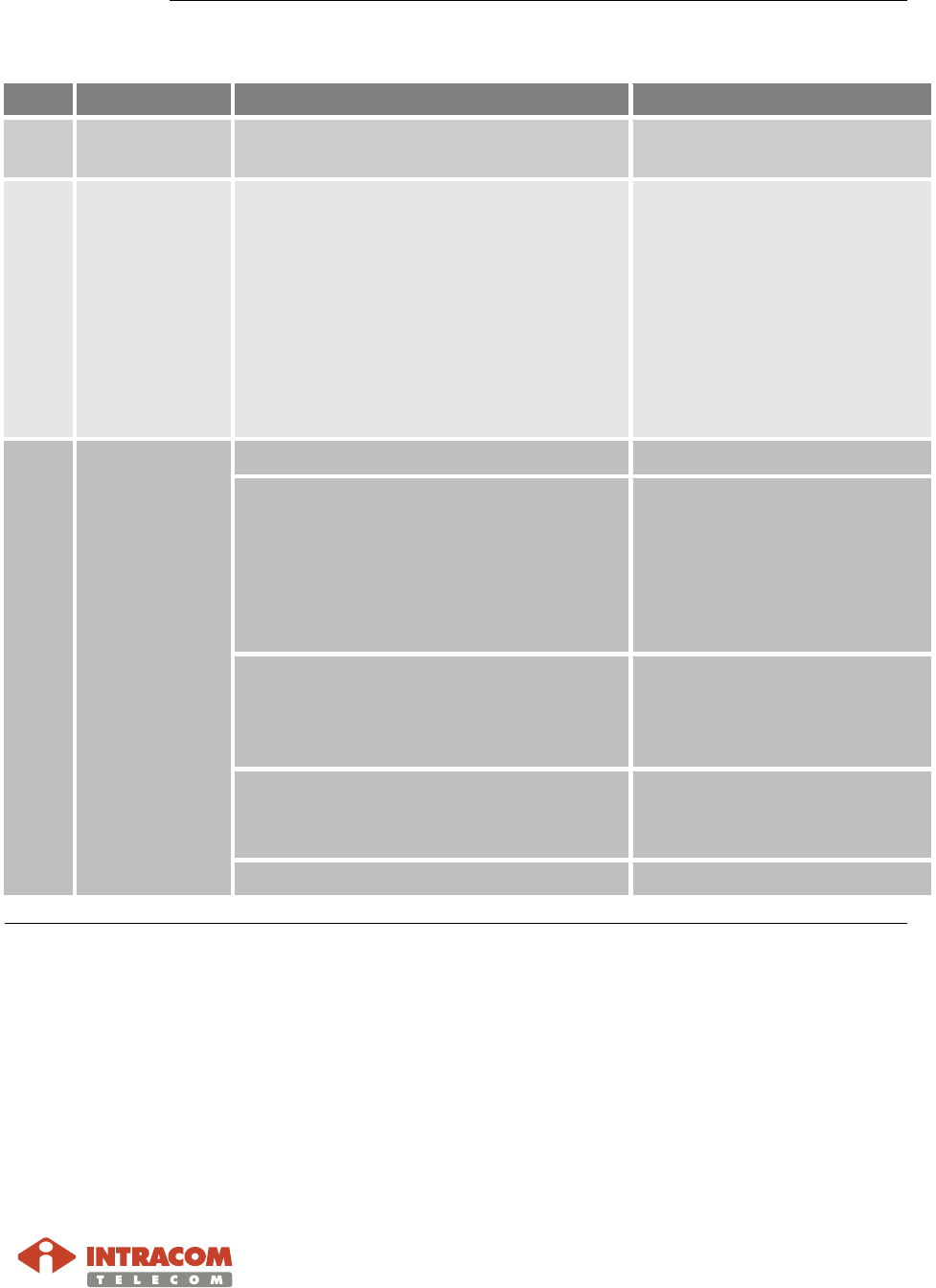
StreetNode 6250 PTP with Embedded Node Manager
WebUI Commissioning Manual – Edition 1.1
9
Startup & Commissioning Procedure, Continued
Overview The commissioning of a StreetNodeTM 6250 PTP unit will be carried as follows:
Step
Action
Details Refer to
1 Visit site A. Install StreetNodeTM 6250 PTP, point it
coarsely toward site B and power it up. StreetNodeTM 6250 PTP
Installation & Cabling Manual.
2 Configure
management. In case the (default) VLAN with id=1 is
to be used, then set:
Acceptable Frame Type = Tagged
and Untagged (modem configuration).
If a different VLAN is to be used, no
such action is required.
Node Manager for
StreetNodeTM 6250 PTP
Reference Manual, Chapters
4 & 5:
§ Configuring the Inband
Management.
§ Adding VLANs / VLAN
Ports.
§ Configuring Bridge.
3 Configure
StreetNode
operation.
a. Set site information. § Adding Site Information.
b. Configure the modem operation.
Set the following:
Min Auto PHY Mode = 4QAM
Max Auto PHY Mode = 4QAM
Adaptive Mode = Auto-Manual
Power
§ Configuring the Modem.
c. Configure the radio parameters.
Set the Tx frequency and Tx power as
provided by the radio planning. Ensure
that Mute = OFF.
§ Configuring the Radio.
d. Configure bridge.
Use the input provided by the
responsible network operation team.
§ Configuring Bridge.
e.
Save node configuration. § Saving Configuration.
Continued on next page
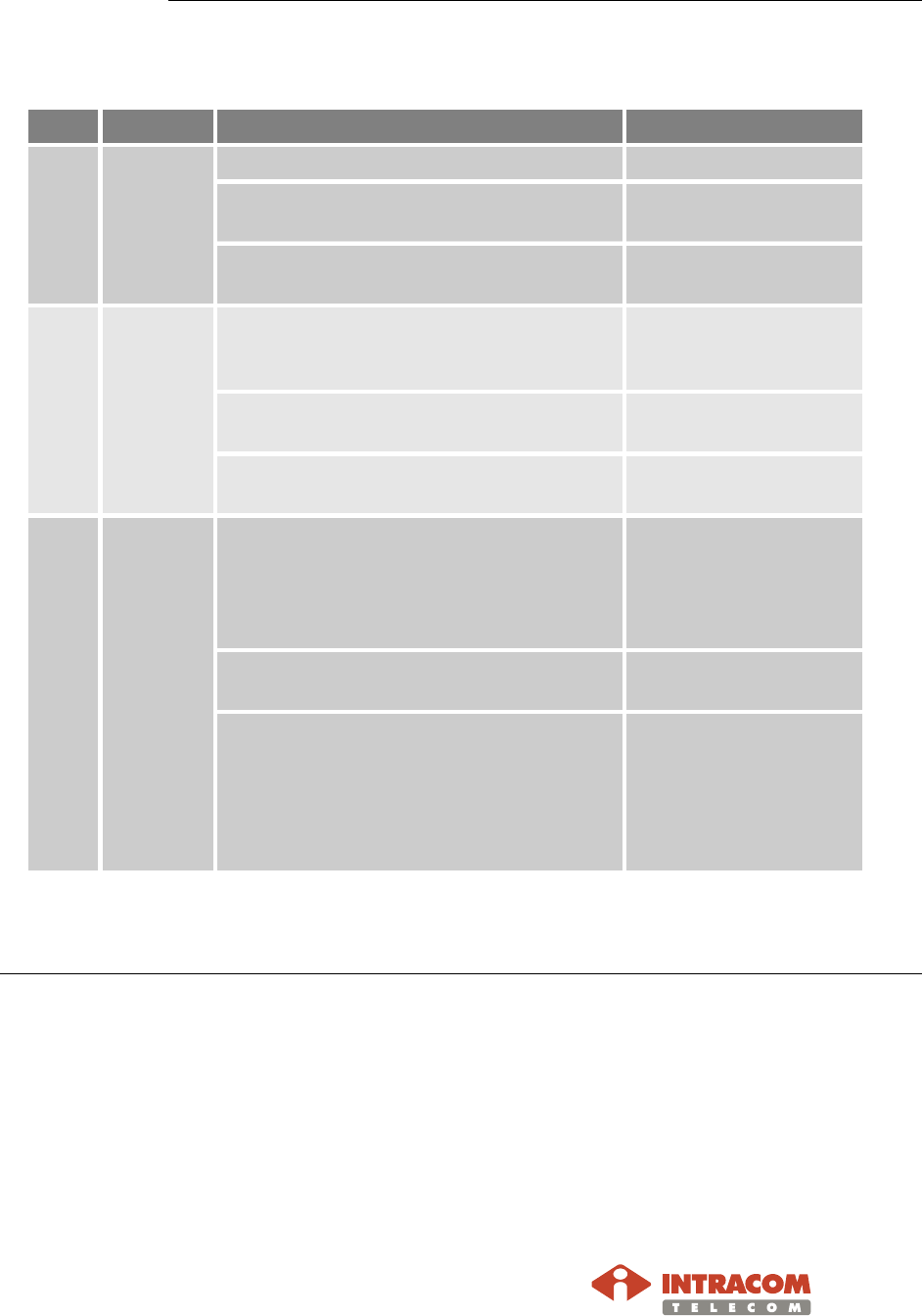
StreetNode 6250 PTP with Embedded Node Manager
WebUI Commissioning Manual – Edition 1.1
10
Startup & Commissioning Procedure, Continued
Overview, continued
Step
Action
Details Refer to
4 Visit site
B.
a.
Repeat steps 1 to 3 for site B. -
b. Perform antenna alignment at
site B.
§ Configuring Antenna
Alignment.
c. Save node B configuration. § Saving
Configuration.
5 Connect
to site A
(from
site B) to
carry out
alignment
.
a. Use your web browser and the
IP address of StreetNode node
at site A.
§ Log in (Chapter 2).
b. Perform antenna alignment at
site A. § Configuring Antenna
Alignment.
c. Save node A configuration. § Saving
Configuration.
6 Link
verificatio
n &
completio
n of
tasks.
a. At site B, ensure that:
Link Status (local/remote) = Locked
Radio Communication Status =
Connected
§ Summary
Information (Section
8.1).
b. Verify that no active alarms exist
for radio, modem & traffic ports. Chapter 7 (Status).
c. Dispatch the IP addresses of all
nodes to the NMS team.
The NMS team will then be able
to take control and proceed to
Ethernet QoS configuration and
Ethernet provisioning.
Section 5.3 (Ethernet
QoS Configuration).
§ Adding VLANs /
VLAN Ports.
End of commissioning procedure.
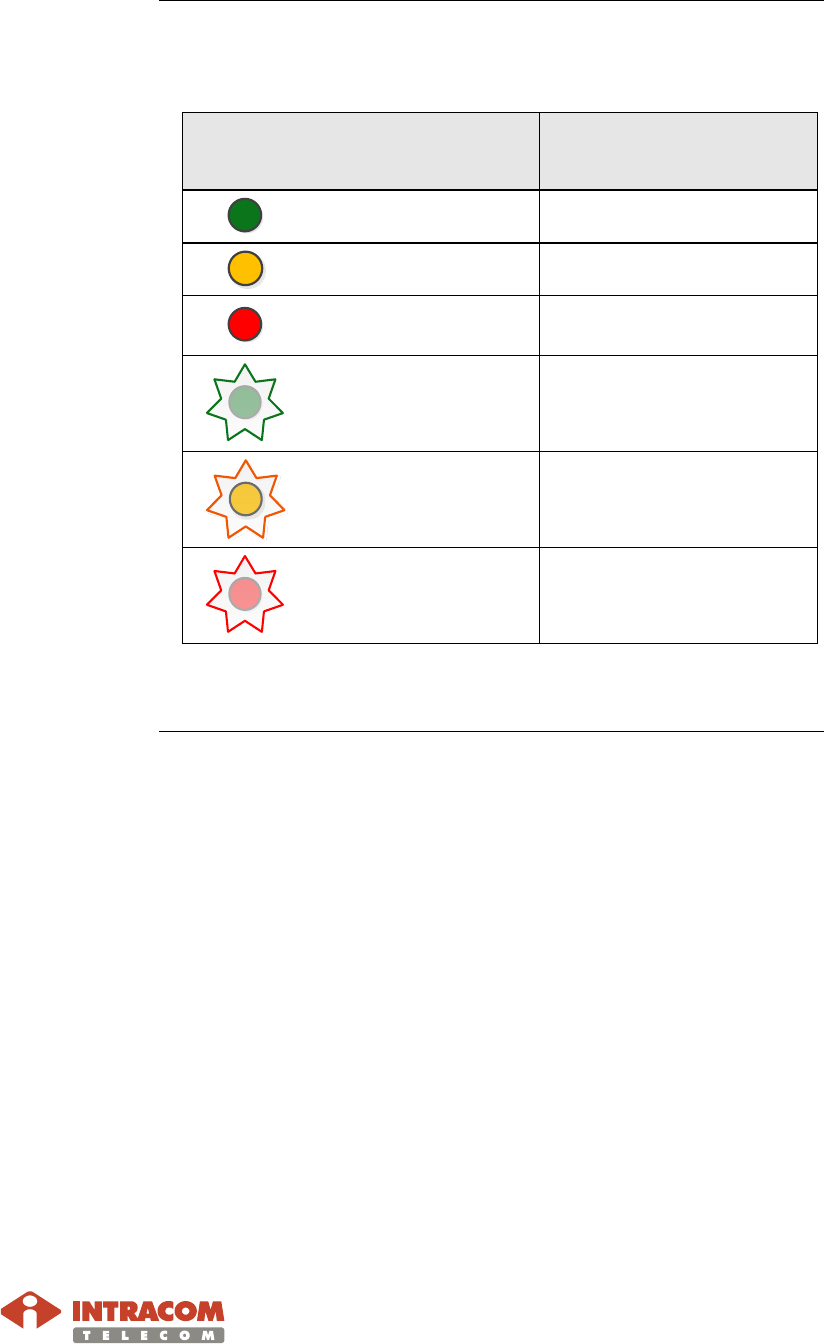
StreetNode 6250 PTP with Embedded Node Manager
WebUI Commissioning Manual – Edition 1.1
11
System LED Indications
The LED at the bottom of StreetNodeTM 6250 PTP unit provides
visual indications of the system status:
LED Status Description
Stable ON, green Ready
Stable ON, orange Modem alarm is active.
Stable ON, red Active alarm (internal or
communication).
Blinking green Link operational.
Blinking orange Waiting for link id.
Blinking red Antenna alignment in
progress.

StreetNode 6250 PTP with Embedded Node Manager
WebUI Commissioning Manual – Edition 1.1
12
Appendix A: Standards of Compliance
This product is in full compliance with the following standards:
Radio/Use of Spectrum:
ETSI EN 302217-3 ν2.2.1 : 2014
ETSI EN 302217-4-2 v1.5.1 : 2010 (antenna)
FCC Part 15.255
EMC / EMI :
ETSI EN 301 489-1 v1.9.2: 2011
EΤSI ΕN 301 489-4 ν2.1.1 : 2012
EΝ 55022:2010
EΝ 61000.3-2:2006 +A1:2009 +A2:2009
EN 61000-3-3:2008
FCC Part 15 Subpart B
Health and Safety:
EΝ 60950-1:2006 +A11:2009 +A1:2010 +A12: 2011
EN 60950-22: 2006
EN 50385 : 2002
EN 60215:1989 +A1:1992 +A2:1994
IEC/UL/CSA 60950-1
IEC/UL/CSA 60950-22
RoHS : EN 50581 :2012
Eco Design: CR (EC) No. 278/2009
Environmental:
ETSI EN 300019-2-4 V2.2.2, Class 4.1 / (Mechanical 4M5)
(Operation)
(Within Spec Operating temperatures: -33°C to +55°C,
Operational at -50°C).
IEC 60529, Class IP67 (Protection against dust and water)
ETSI EN 300 019-2-2 v2.1.2, Class 2.3 (Transportation)
ETSI EN 300 019-2-1 v2.1.2, Class 1.2 (Storage)

StreetNode 6250 PTP with Embedded Node Manager
WebUI Commissioning Manual – Edition 1.1
13
Glossary
BW
Bandwidth
CBS
Committed Burst Size
CIR
Committed Information Rate
CLI Command Line Interface
CoS
Class of Service
CRC
Cyclic Redundancy Check
DCN Data Communication Network
DSCP
Differentiated Services Code Point
FDB
Forwarding Database
IP Internet Protocol
L2CP
Layer 2 Control Processing
LDPC
Low-Density Parity Check
LED
Light Emitting Diode
PDU
Protocol Data Unit
PoP
Point of Presence
PtP (PTP)
Point-to-Point
QAM
Quadrature Amplitude Modulation
QL
Quality Level
QoS
Quality of Service
RAI
Remote Alarm Indication
RMON
Remote network MONitoring
RRC
Radio Resource Control
RSSI
Received Signal Strength Indicator
RSTP Rapid Spanning Tree Protocol
SNMP
Simple Network Management Protocol
SNR
Signal-to-Noise Ratio
SP Strict Priority
S-VLAN
Service VLAN
TCM
Three Color Marking
VLAN Virtual Local Area Network
